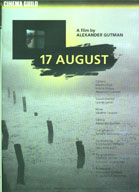
17 August 2009
Distributed by Cinema Guild, 115 West 30th Street, Suite 800, New York, NY 10001; 212-685-6242
Produced by Alexander Gutman and Krzysztof Kopczynski
Directed by Alexander Gutman and Krzysztof Kopczynski
DVD, color, 53 min.
College - Adult
Russia, Criminal Justice, Sociology, Psychology
Date Entered: 12/02/2010
Reviewed by Andrew Jenks, California State University, Long BeachThis is a strange and haunting documentary: a typical day in the life of a Russian murderer condemned to life in prison. The documentary offers no historical context or explanation—one must gain that from the information on the DVD box. Instead, director Alexander Gutman sends his camera through the eye-hole of the prisoner’s cell observing his day. He then presents the results of that exercise—along with shots of the prison corridor, the guards, and the courtyard—minus any commentary or explanation. The documentary is nonetheless compelling, forcing the viewer to confront the horror of daily life for a prisoner who will spend the rest of his life, in all likelihood, in an isolated cell. The film also has a perverse appeal. As with Jeremy Bentham’s infamous Panopticon (2009), the filmmaker can observe the prisoner but he cannot see or hear the filmmaker. The viewer, like the filmmaker, is thus put into the perspective of a prison guard.
As with Solzhenitsyn’s One Day in the Life of Ivan Denisovich (1970)—clearly the inspiration for the documentary—the prisoner’s day begins with a 5:00 am reveille. Throughout the day he has no one to speak with but himself. The guards, who seem not recognize his humanity, do not engage him in conversation. Instead, they issue terse commands (“Enter,” “Exit,” “Hands against the wall!), as if he were a dog. They open his cell for a morning inspection, when meals are brought to his door and when he is allowed out for his daily exercise: a half hour in an outdoor cage with four cement walls and bars on top. A guard paces methodically back and forth above him on a wooden plank.
It is difficult to imagine the prisoner described on his prison-cell door: “Boris Besotechestvo [the name in Russian means “without a fatherland”], dangerous, aggressive, a three-time murderer.” Rather than a murderous sociopath, the prisoner comes across as a sympathetic figure, praying for forgiveness, doing his best to keep himself mentally and physically fit, fearing that his hopeless position will eventually make him lose his mind. His companion is the spider that occupies his room, with whom he keeps up a running conversation.
The prison itself, the viewer learns from the DVD box, was built as a monastery in 1517 and converted by the Bolsheviks into a prison. It is located on an island in a remote lake 400 kilometers north of Moscow. Stalin’s enemies—the lucky ones who were not shot—were held there in the 1930s and 1940s. The prison survived the collapse of the Soviet Union, becoming a penitentiary for Russia’s most hardened criminals—those who would have been executed if not for a moratorium on capital punishment declared in 1996 by President Boris Yeltsin. The filming itself took place in 2006.
If the moratorium was conceived as an act of compassion, the prison makes clear that the alternative—condemned to live the rest of one’s life in this place—is hardly more humane. Prison life as captured in the documentary resembles a feverish nightmare: claustrophobia, insanity, isolation, loneliness, hopelessness, desperation. The haunting images—desolate and barren landscapes, grey skies and weak sun light—accentuate the film’s atmosphere of unrelenting despair. The sounds of the prison enhance the sense of dread. Like Chinese water torture, the sink in the prisoner’s room is constantly dripping into a basin. The sound of rain on the metal roof becomes nearly deafening. The daily life of the prison routine is audible from the prisoner’s cell: metal doors clanging shut, the groans and muffled voices of prisoners in other cells. The soundtrack of the documentary mixes in strange metallic sounds. If there is hell on earth, this is it.
At times, the prisoner appears like a caged animal: taut, lithe, methodically performing push-ups, pull-ups, and stretching routines. But then he softens as he prays and ruminates out loud by the inhumanity of humanity and the hopelessness of his position. An icon on the shelf—an image of a crying Jesus on the cross—bears the inscription “This is my blood!” To maintain his sanity, he keeps a strict routine and constantly checks his watch: time for a smoke, time for push-ups, time to look out the window, time to eat, time to shave (without a mirror), time to stretch, time to pray, time to smoke. The food, of course, is awful: a watery gruel of cabbage soup with a disgusting piece of mystery meat. He asks the guard if there will be milk that day to wash down his allowance of Russian rye bread. “No.”
The documentary ends with another haunting scene: a prisoner who is released from his prison term by dying a natural death. The camera follows the transport of the body on a gurney to the place where the death is registered and the prisoner put into a rudimentary pine-box coffin. A horse-drawn cart then takes the coffin down a long dock to be loaded on a boat to the mainland—followed by the half-crazed eyes of the prisoners from their cell-block windows, perhaps envying his fate.
This film is sure to stimulate interesting discussions from students in a variety of disciplines: criminal justice, sociology, Russian studies, psychology, and anthropology. Its main drawback is the absence of any attempt to explain historical and social context. I also would have liked to know what the prison officials think of their prison. Along with the Russian Ministry of Justice, they had given permission to Gutman to make this unusual film. Did they do so enthusiastically? Why did they do so? Do they believe the system needs to be reformed? Do they sympathize with their prisoners’ plight? Students will have to imagine the answers to these questions.